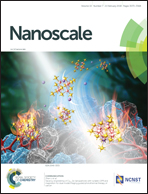An implanted paramagnetic metallofullerene probe within a metal–organic framework†
Abstract
Paramagnetic endohedral metallofullerene can be used as a molecular probe because of its sensitive electron spin characters, one of which is to sense its surroundings. Metal–organic framework (MOF) materials have significant applications in selective adsorption owing to their porous structures. Herein, we report a Sc3C2@C80 spin probe implanted in MOF-177 to detect the unusual host–guest interaction between the guest molecules of metallofullerene and the host pores of the MOF. Paramagnetic Sc3C2@C80 molecules were incorporated into the pores of MOF-177 via absorption method, and there was strong π–π interaction between oleophilic metallofullerene and aromatic framework. The electron paramagnetic resonance (EPR) signals of Sc3C2@C80 in MOF-177 exhibit anisotropic properties caused by the restricted motion of implanted Sc3C2@C80. This unusual host–guest interaction between Sc3C2@C80 and MOF-177 is gradually strengthened with decreasing temperature as revealed by the EPR signals. In addition, the gas desorption from the MOF-177 pores under subatmospheric pressure can weaken the host–guest interaction and lead to slightly enhanced Sc3C2@C80 EPR signals. Furthermore, the changes in the host–guest interaction between Sc3C2@C80 and MOF-177 at different temperatures and pressures exhibit reversibility, as shown by cycling EPR measurements. These results will inspire material design and applications of fullerene and MOF complexes.



 Please wait while we load your content...
Please wait while we load your content...